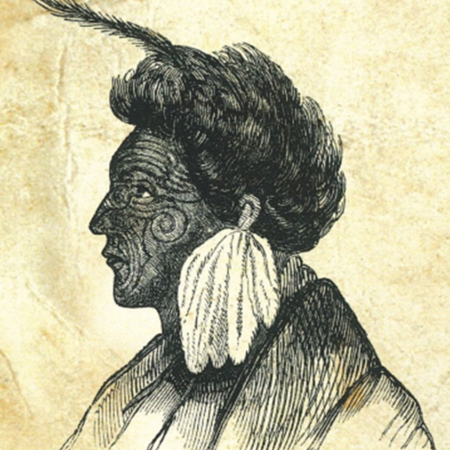The fearsome chief Te Rauparaha is particularly well known for the frequent armed expeditions he led to the South Island. These enabled him to control some of the northern parts of the South Island and exact loot from and revenge on Ngāi Tahu. He was taken into custody by British Troops in 1846 and returned to live in Otaki in 1848, now a sick and elderly man. In his late life he organised the construction of a church in Otaki. Building soon got underway, after soil from the Hawaiki had been poured on the site. And so the church was named Rangiātea, part of the ancestral homeland. Te Rauparaha died before the church was completed in 1851. He does not seem to have embraced Christianity, but recognised the advantages that the missionaries brought.
Rangiātea Church combined European and Māori traditions. Large totara logs were floated from the Tararua Ranges. Expert carvers adorned the interior of the church with intricate patterns. Tukutuku panels lined the walls. In 1995 Rangiātea Church was burned to the ground by an arsonist. The Parish decided to build a replica of the church at the same location. Under special provisions totara logs were again brought from the Tararua Ranges. Carvers recreated the intricate woodwork. Weavers made new tukutuku panels and the Church was opened in all its glory in 2003.
I visited Rangiātea Church in 2017 among a group of St John’s College students. After seeing the plain exterior, the beauty of the interior impressed me. We asked the warden showing us around whether they derived some satisfaction from replicating such a beautiful church. He said that yes, the church was very beautiful, but that knowing what they know now, they would never do it again. They would just build a small, plain church. “Why?” we asked. He said: “We are just a church with the same problems as other churches. A small, dwindling, elderly congregation. We normally don’t fill this church. We don’t have the finances to maintain it.”
We students were a bit shocked to find out that this was just a normal parish with the same struggles as other parishes. Somehow we had assumed that such a famous Māori church would have access to funding that other churches don’t have. We assumed that it must have government or community support or some big trust fund. But that is not the case with a church. I do hope that ways can be found to keep the heritage of these churches alive and that at the same time they continue to remind people about God and bring them closer to God’s love.

